Tugboat Sailors Forsake 7 Seas for Calm Harbors
As the dawn cast a reddish glow over low clouds in the eastern sky, the Pacific Queen nudged an empty barge the size of a football field gently toward a pier in Los Angeles Harbor.
Rene Dominguez, the jovial, bearded skipper of the Long Beach-based tugboat, backed his stumpy vessel away from the barge. He deftly manipulated the helm and throttle as he talked over the radio to his counterpart aboard the Pacific Escort at the other end of the barge.
“OK, Ron, I’m backing,” Dominguez said, speaking into a microphone dangling from the ceiling of the wood-lined pilothouse. The 2,500-horsepower engines responded to a push of the throttle into reverse. The boat shuddered. The calm green water astern boiled in a swirling mass of whirlpools.
With every push or pull, the barge inched closer to a smooth tie-up at the dock. Finally, a crewman from the other tug released the tow line. The task was complete and the Pacific Queen and Pacific Escort were off to their next assignment.
Virtually Marooned
Tugboats are the backbone of port commerce. Without them, the towering container ships or car carriers that haul goods to Southern California would be virtually marooned like whales in a fish pond. When it comes to keeping the harbor traffic moving, “it all depends on the tugboat men,” Dominguez said.
While sailors see the world, many tugboat skippers and crewmen see little more than the harbor. “I’ve never really been outside that lighthouse,” said Dominguez, a 30-year tugboat veteran, as he motioned in the direction of Angel’s Gate while awaiting the arrival of a cruise ship. “It’s more fun in here.”
Dominguez, 53, is a gruff-voiced but unassuming man. He is quick to smile and contribute to some of the good-natured kidding with his crew.
He said he joined a tugboat crew on the advice of his brother-in-law. “I just fell into it,” he said. In the 1950s, he said crew members sought jobs aboard long-range tugs helping to build the offshore oil platforms near Santa Barbara, leaving the harbor jobs open.
Dominguez said he was aboard one of the 14 tugboats that moved the Queen Mary around Long Beach Harbor before the 81,000-ton behemoth was permanently moored on Pier J as a hotel and tourist attraction.
‘That’s My Trademark’
A nine-year employee of PacTow, which operates six tugs from offices aboard a converted Navy barge moored in Long Beach Harbor, Dominguez said he is known in the harbor by his greeting. He dangles a white handkerchief from the open pilothouse window to passing tugboats. “That’s my trademark. I’ve been doing it for years,” he said.
Dominguez said he is widely known because there is relatively little turnover among crews. “The same people have been around. You don’t see many new faces,” Dominguez said.
One reason for the stable labor force is good pay: $45,000 a year for a deckhand and more for a skipper, although prospective workers sometimes have to wait around union halls for months or years before landing full-time jobs. There are relatively few of the lucrative jobs available.
The job also offers a lot of days away from work. After four days of 12-hour shifts, the crew is off for either four or five days, depending on scheduling. Dominguez, a father of four, said he spends his off-hours golfing, camping and cooking.
When he is working, Dominguez is usually at the controls of his tug as deckhand Brian Hall, 34, handles the seven-inch-thick lines that are attached to ships, and engineer Krunos Jaksic, 57, tends to the engines and assists Hall.
The tug typically assists about three ships per shift in addition to maintenance and other tasks. Each ship assist takes about 40 minutes.
During slack hours on the overnight shift, Dominguez and his crew sometimes snooze in bunks adjoining the simple but utilitarian galley or perform light maintenance. Underway, Dominguez is always stationed in the pilothouse behind the dials and levers.
On one crisp morning, the perpetual smell of salt air and fuel was replaced for an instant by a distinctly sweet odor as the boat ran through San Pedro’s main channel. “Smell the French bread?” Dominguez asked his visitor. The aroma emanated from a large commercial bakery a couple of miles upwind.
As the last job for that day, the crew of the Pacific Queen escorted the cruise ship Azure Seas to its berth in Los Angeles Harbor so it could take on another load of Mexico-bound tourists. Deckhand Hall carefully wrapped white canvas around the tires that pad the tug’s bow to try to keep them from streaking the ship’s gleaming white hull. The cruise line requires the precaution, but it is only partially successful, judging from the black marks left by previous tugs.
As the cruise ship steamed into the inner harbor, Dominguez set a parallel course and carefully brought the tug firmly against the ship’s port side just aft of the bow. The tug pushed and pulled the giant ship until longshoremen could secure its lines.
Dominguez’s long shift was still an hour from being finished. He was worn, but not bored by his surroundings.
“To me, this is the most beautiful place in the world--the harbor. You don’t get tired of it,” he said.
More to Read
Sign up for Essential California
The most important California stories and recommendations in your inbox every morning.
You may occasionally receive promotional content from the Los Angeles Times.










